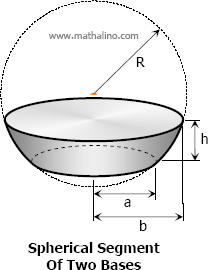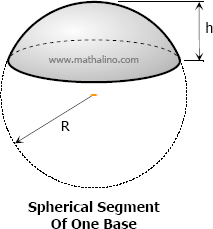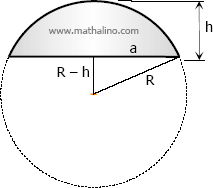Spherical Segment
Spherical segment is a solid bounded by two parallel planes through a sphere. In terms of spherical zone, spherical segment is a solid bounded by a zone and the planes of a zone's bases.

Properties of Spherical Segment

- The bases of a spherical segment are the sections made by the parallel planes. The radii of the lower and upper sections are denoted by a and b, respectively. If either a or b is zero, the segment is of one base. If both a and b are zero, the solid is the whole sphere.
- If one of the parallel planes is tangent to the sphere, the solid thus formed is a spherical segment of one base.
- The spherical segment of one base is also called spherical cap and the two bases is also called spherical frustum.
- The altitude of the spherical segment is the perpendicular distance between the bases. It is denoted by h.
Formulas for Spherical Segment
The total area of segment of a sphere is equal to area of the zone plus the sum of the areas of the bases.
$A = A_{zone} + A_1 + A_2$
$A = 2\pi Rh + \pi a^2 + \pi b^2$
The volume of spherical segment of two bases is given by
 The formula for the volume of one base can be derived from volume of two bases with b = 0. Consider the following diagram:
The formula for the volume of one base can be derived from volume of two bases with b = 0. Consider the following diagram:
$a^2 + (R - h)^2 = R^2$
$a^2 + (R^2 - 2Rh + h^2) = R^2$
$a^2 = 2Rh - h^2$
Substitute a2 = 2Rh - h2 and b = 0 to the formula of spherical segment of two bases
$V = \frac{1}{6}\pi h(3a^2 + 3b^2 + h^2)$
$V = \frac{1}{6}\pi h \, [ \, 3(2Rh - h^2) + 3(0^2) + h^2 \, ]$
$V = \frac{1}{6}\pi h \, [ \, 6Rh - 3h^2 + h^2 \, ]$
$V = \frac{1}{6}\pi h \, [ \, 6Rh - 2h^2 \, ]$
$V = \frac{1}{6}\pi h (2h) [ \, 3R - h \, ]$
$V = \frac{1}{3}\pi h^2 (3R - h)$ (okay!)
Note also that the volume of segment of a sphere of altitude h and radii a and b is equal to the volume of a sphere of radius h/2 plus the sum of the volumes of two cylinders whose altitudes are h/2 and whose radii are a and b, respectively.
- Log in to post comments
